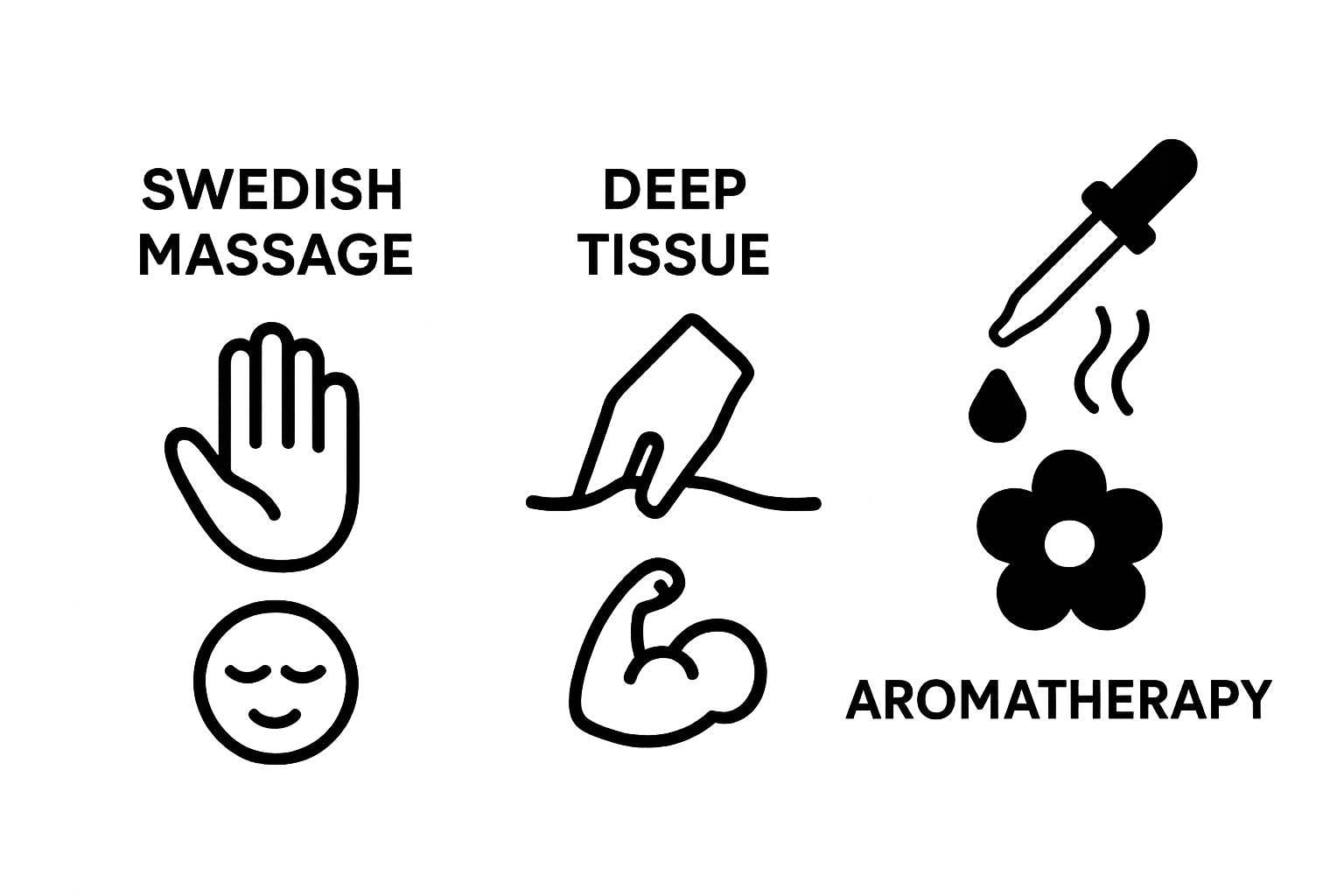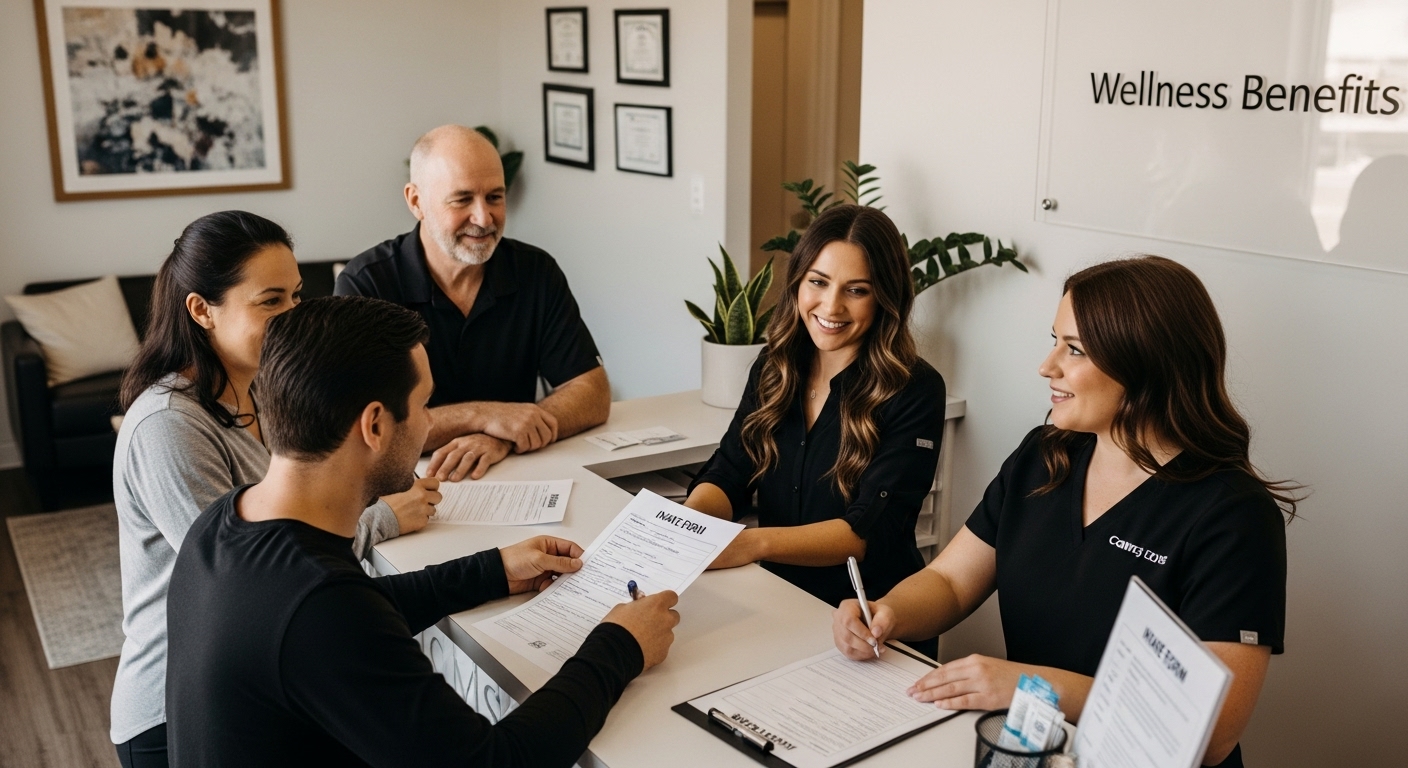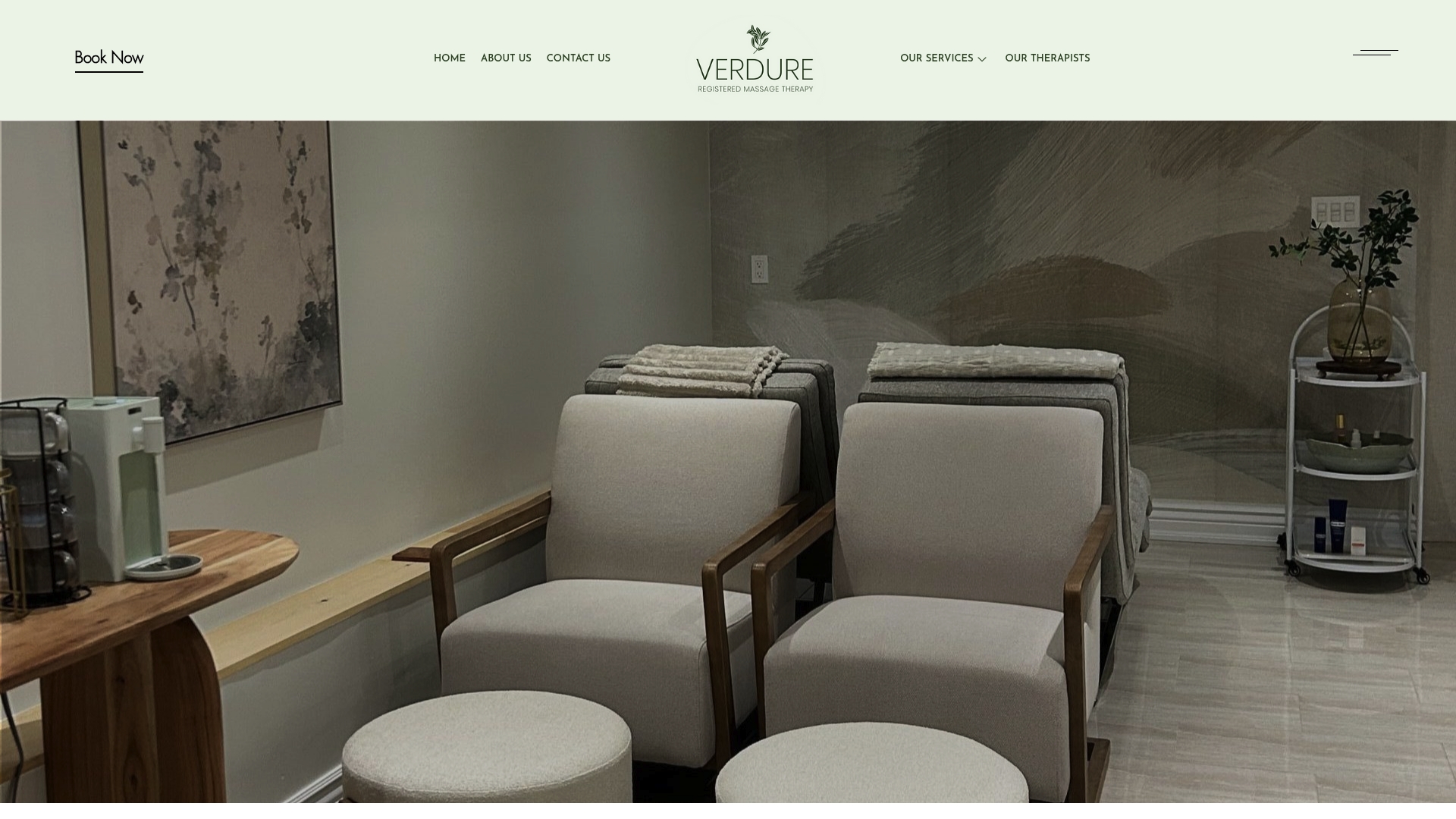Feeling mentally fried or physically tense is almost a daily ritual for most Americans. Here is something that might surprise you. Scientists have found that Swedish massage can actually lower your cortisol levels and boost your mood in a single session. Most people think finding the right massage for relaxation is just about preference or comfort. The real secret is that each style taps into different biological triggers, making your choice much more powerful than you might suspect.
Table of Contents
Quick Summary
| Takeaway | Explanation |
| Choose a massage style based on personal needs | Evaluate your physical and emotional wellness goals to select the most appropriate massage technique tailored for you. |
| Swedish massage promotes overall relaxation | This classic technique utilizes flowing strokes to reduce tension and lower stress hormones, enhancing both physical and psychological wellness. |
| Deep tissue targets chronic muscle tension | Ideal for individuals with persistent pain, this massage style applies deeper pressure to relieve tension in muscles and connective tissues. |
| Holistic approaches enhance relaxation experiences | Techniques like aromatherapy and reflexology use essential oils and pressure points to provide unique relaxation benefits beyond traditional massage. |
| Regular massage can support long-term wellness | Consistent sessions contribute to improved emotional regulation and overall health, making massage a valuable part of wellness routines. |
What are the Different Massage Styles for Relaxation?
Massage styles for relaxation offer diverse approaches to reducing stress, alleviating muscle tension, and promoting overall wellness. Understanding the unique characteristics of each technique helps individuals select the most appropriate method for their specific physical and emotional needs.
Swedish Massage: The Classic Relaxation Technique
Swedish massage represents the foundational approach to relaxation bodywork. Developed in the 19th century by Per Henrik Ling, this technique focuses on long, flowing strokes designed to calm the nervous system and release muscular tension. Therapists utilize five primary movements: effleurage (gentle gliding), petrissage (kneading), tapotement (rhythmic tapping), friction (deep circular movements), and vibration.
According to a comprehensive review in the International Journal of Environmental Research and Public Health, Swedish massage not only promotes physical relaxation but also significantly reduces psychological stress markers. Clients often experience decreased cortisol levels and improved overall mood after sessions.

Deep Tissue and Therapeutic Relaxation Approaches
While relaxation is the primary goal, some individuals require more targeted techniques to address chronic muscle tension. Deep tissue massage provides a more intense approach, using slower strokes and deeper finger pressure to target underlying muscle layers and connective tissues.
Key benefits of deep tissue and therapeutic massage styles include:
-
Releasing chronic muscle tension
-
Improving blood circulation
-
Reducing inflammation
-
Promoting faster muscle recovery
-
Enhancing overall body flexibility
Holistic Relaxation Techniques
Beyond traditional massage, holistic approaches like aromatherapy massage and reflexology offer unique relaxation experiences. Aromatherapy massage integrates essential oils to enhance the therapeutic effect, while reflexology focuses on specific pressure points in the feet and hands to induce whole-body relaxation.
Each massage style offers a distinct pathway to relaxation, allowing individuals to choose a technique that resonates with their physical and emotional wellness goals.
Below is a comparison table outlining key characteristics, techniques, and benefits associated with the major massage styles for relaxation discussed in this article.
| Massage Style | Key Techniques | Main Benefits | Targeted Needs |
| Swedish Massage | Long, flowing strokes; kneading; rhythmic tapping; deep friction; vibration | Promotes relaxation, reduces tension, lowers stress hormones, boosts mood | General relaxation, stress reduction |
| Deep Tissue Massage | Slow, deep strokes; focused finger pressure | Releases chronic tension, improves circulation, reduces inflammation, aids muscle recovery | Chronic muscle pain, persistent tension |
| Aromatherapy Massage | Massage with essential oils | Enhances relaxation, supports emotional balance, induces whole-body calm | Sensory relaxation, mood enhancement |
| Reflexology | Pressure on specific hand/foot points | Induces relaxation, improves energy flow, stimulates overall well-being | Holistic relaxation, stress management |
The key is understanding personal preferences, physical conditions, and desired outcomes when selecting a massage approach.
Why Massage Matters for Stress Relief and Wellness
Massage therapy transcends simple physical manipulation, emerging as a powerful holistic approach to managing stress and promoting comprehensive wellness. By understanding its profound physiological and psychological impacts, individuals can harness massage as a strategic tool for overall health optimization.
The Science of Stress Reduction
Stress creates complex physiological responses that can significantly compromise health. Massage interrupts these harmful stress cycles by directly influencing the nervous system. When skilled hands apply therapeutic touch, the body triggers a cascade of beneficial neurochemical responses.
Physiological benefits include:
-
Lowering cortisol (stress hormone) levels
-
Increasing serotonin and dopamine production
-
Reducing muscle tension and associated pain
-
Improving overall immune system functionality
-
Promoting deeper, more restorative sleep patterns
According to Johns Hopkins Medicine, massage therapy systematically reduces pain and supports healing by strategically manipulating muscles and soft tissue, creating a profound sense of physical and emotional calm.
Holistic Wellness and Mental Health
Beyond physical relief, massage serves as a critical intervention for mental wellness. The therapeutic touch provides a sanctuary from daily pressures, allowing individuals to reset their mental and emotional states. Regular massage sessions can significantly mitigate symptoms of anxiety, depression, and chronic stress.
The mind-body connection becomes particularly evident during massage, where physical relaxation directly translates into mental tranquility. This integrated approach acknowledges that emotional well-being cannot be separated from physical health.
Long-Term Health Benefits
Consistent massage therapy is not a luxury but a proactive health strategy. By addressing stress at its physiological roots, massage supports long-term wellness through sustained interventions that prevent chronic health complications.
Individuals who incorporate regular massage into their wellness routines often experience enhanced resilience, improved emotional regulation, and a more balanced approach to managing life’s challenges. The cumulative effect of these sessions extends far beyond the immediate moment of relaxation, creating a foundation for sustained physical and mental health.
How Various Massage Techniques Promote Relaxation
Massage techniques offer sophisticated pathways to relaxation by engaging multiple physiological systems simultaneously. Understanding how different approaches interact with the body reveals the complex mechanisms behind therapeutic touch and its profound impact on stress reduction.
Neurological Relaxation Mechanisms
Each massage technique triggers specific neurological responses that transform the body’s stress state. The human nervous system contains two primary branches: the sympathetic (fight or flight) and parasympathetic (rest and digest) systems. Targeted massage techniques strategically shift nervous system dominance from heightened stress states to calm, restorative modes.
Neurological relaxation pathways include:
-
Reducing cortisol and stress hormone production
-
Stimulating oxytocin release (the “connection” hormone)
-
Decreasing heart rate and blood pressure
-
Enhancing overall nervous system regulation
-
Promoting deep breathing and muscular release
According to a systematic review in the International Journal of Therapeutic Massage & Bodywork, specific massage techniques like Swedish and deep tissue massage demonstrate measurable reductions in physiological stress indicators through precise nervous system modulation.
Physiological Relaxation Responses
Massage techniques engage multiple body systems beyond the nervous network. Physical manipulation of muscles, connective tissues, and skin triggers cascading relaxation responses. Gentle pressure and rhythmic movements stimulate circulation, release muscular tension, and activate the body’s natural healing mechanisms.
When massage therapists apply targeted techniques, they create a comprehensive relaxation experience that addresses both physical and psychological tension. The strategic application of pressure, direction, and rhythm communicates safety and comfort to the body’s internal systems.
Psychological Relaxation Dimensions
Relaxation extends beyond physical manipulation into profound psychological territories. Massage provides a structured, intentional space for mental disengagement from daily stressors. The combination of therapeutic touch, controlled environment, and focused attention creates a meditative experience that resets mental and emotional states.
Individuals experiencing massage enter a unique neurological state where protective psychological barriers soften, allowing deeper relaxation and emotional processing. This holistic approach recognizes that true relaxation involves synchronizing body, mind, and emotional landscapes into a harmonious, peaceful state.
Key Concepts Behind Relaxation Massage Styles
Relaxation massage styles represent sophisticated therapeutic approaches designed to restore physiological balance and promote holistic wellness. These techniques go beyond simple physical manipulation, engaging complex neurological and physiological systems to create profound healing experiences.
Foundational Principles of Touch Therapy
Touch represents a fundamental communication mechanism between human nervous systems. Relaxation massage styles leverage this intrinsic biological response, utilizing specific pressure, rhythm, and intention to transform the body’s stress states. Professional massage therapists understand that therapeutic touch is both an art and a science, requiring precise understanding of human anatomy and neurological responses.
The foundational principles of therapeutic touch in relaxation massage are organized below to illustrate how these concepts support both physical and mental well-being.
| Principle | Description |
| Intentional and mindful contact | Therapist applies focused, conscious touch for healing purposes |
| Understanding body responses | Responding to client cues and adapting techniques as needed |
| Safe, supportive environment | Creating a comfortable, trusting atmosphere for optimal relaxation |
| Body-mind interconnectedness | Addressing the link between physical and emotional states |
| Dynamic response to signals | Adjusting touch in real time based on physiological client feedback |
Core touch therapy principles include:
-
Intentional and mindful physical contact
-
Understanding individual body responses
-
Creating safe, supportive therapeutic environments
-
Recognizing body-mind interconnectedness
-
Responding dynamically to client’s physiological signals
According to a comprehensive review in the International Journal of Therapeutic Massage & Bodywork, relaxation massage techniques systematically employ gentle, flowing strokes to stimulate the parasympathetic nervous system and decrease stress hormones.
Neurological Engagement Strategies
Relaxation massage styles strategically target the autonomic nervous system, transitioning the body from sympathetic (stress) to parasympathetic (rest) states. By applying specific touch techniques, massage therapists can effectively interrupt chronic stress patterns and reset neurological responses.
These techniques work by sending calming signals through nerve pathways, reducing cortisol production, increasing oxytocin release, and promoting overall physiological relaxation. The carefully orchestrated manipulation of soft tissues communicates safety and comfort to the body’s internal systems.
Holistic Wellness Integration
Relaxation massage transcends physical treatment, representing a comprehensive wellness intervention. These styles recognize that true healing involves synchronizing physical, mental, and emotional landscapes. By creating intentional, therapeutic spaces, massage becomes more than a technique—it transforms into a profound healing experience.
Practitioners approach each session as a unique journey, adapting techniques to individual client needs and responses. The goal extends beyond temporary relief, focusing on establishing sustainable pathways to balanced, resilient health.
The Benefits of Choosing the Right Massage Style
Selecting the appropriate massage style is a nuanced process that directly impacts physical wellness, emotional balance, and overall health outcomes. Understanding the unique characteristics of different massage approaches enables individuals to make informed decisions that maximize therapeutic potential and personal comfort.
Personalized Wellness Strategies
Each massage style offers distinct therapeutic mechanisms designed to address specific physical and psychological needs. The art of selecting the right massage technique involves carefully evaluating individual health conditions, stress levels, and personal wellness goals. This personalized approach transforms massage from a generic treatment into a targeted healing intervention.
Key considerations for massage style selection include:
-
Current physical health status
-
Specific areas of muscular tension or pain
-
Personal stress and anxiety levels
-
Desired therapeutic outcomes
-
Individual pain tolerance and comfort preferences
According to a systematic review in the International Journal of Therapeutic Massage & Bodywork, tailoring massage styles to individual needs can significantly enhance perceived effectiveness and overall wellness outcomes.
Targeted Therapeutic Outcomes
Different massage styles produce unique physiological responses. Swedish massage might promote general relaxation, while deep tissue techniques address chronic muscle tension. Sports massage focuses on athletic performance and recovery, and prenatal massage supports expecting mothers through specialized techniques.
The precision of matching massage style to specific health requirements cannot be overstated. A well-chosen massage technique can accelerate healing, reduce inflammation, improve circulation, and support the body’s natural restoration processes. This targeted approach transforms massage from a luxury experience to a strategic wellness intervention.
Holistic Health Optimization
Beyond immediate physical benefits, the right massage style contributes to comprehensive health optimization. By addressing not just physical symptoms but underlying stress patterns, massage becomes a powerful tool for preventative healthcare. The carefully selected technique can help regulate nervous system responses, improve emotional resilience, and create sustainable pathways to balanced well-being.
Professional massage therapists serve as skilled navigators, helping clients discover the most effective massage approach for their unique physiological and emotional landscapes. The journey toward optimal wellness begins with understanding that massage is not a one-size-fits-all solution, but a personalized healing art.

Ready to Find Your Perfect Massage Style?
Exploring different massage techniques—like Swedish massage, deep tissue therapy, and whole-body relaxation—is the first step toward meaningful well-being. If you are searching for lasting relief from stress, craving deep relaxation, or hoping for help with chronic muscle tension, Verdure Registered Massage Therapy offers the expertise and tailored care you need. Our experienced RMTs draw on a wide range of approaches to address your unique concerns in a calm, welcoming space. Our clinic values transparency, client comfort, and a truly personalized healing experience.

Your next step is simple. Visit Verdure Registered Massage Therapy to learn more about our massage offerings, meet your future therapist, or book your first session. Don’t leave your well-being to chance. Secure your appointment today and let skilled hands guide you on your journey to relaxation and long-term wellness.
Frequently Asked Questions
What are the different types of massage styles for relaxation?
Massage styles for relaxation include Swedish massage, deep tissue massage, aromatherapy massage, and reflexology. Each technique has its unique approach, addressing various physical and emotional needs.
How does Swedish massage promote relaxation?
Swedish massage uses long, flowing strokes and a combination of techniques to soothe the nervous system and reduce muscle tension. It helps lower cortisol levels and improve mood, leading to a profound sense of relaxation.
What are the benefits of deep tissue massage for relaxation?
Deep tissue massage focuses on deeper layers of muscle and connective tissue, particularly helpful for chronic tension. Benefits include relief from muscle pain, improved circulation, reduced inflammation, and enhanced flexibility.
Why is it important to choose the right massage style?
Selecting the appropriate massage style is crucial to address individual health concerns effectively. A tailored approach ensures that the chosen technique meets specific needs, optimizing relaxation, pain relief, and overall wellness.
